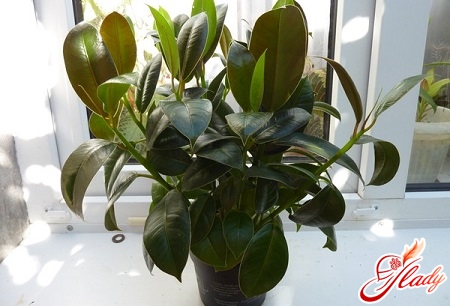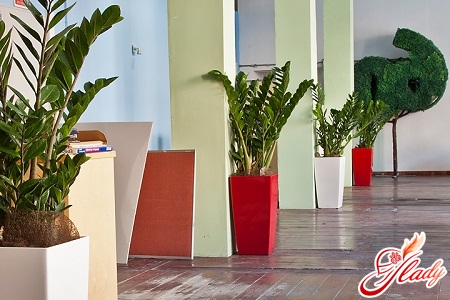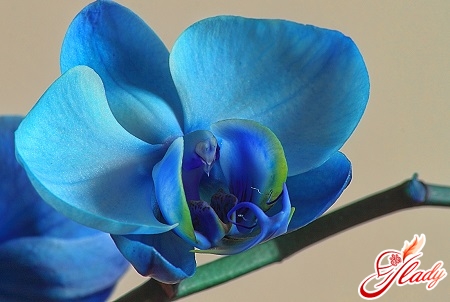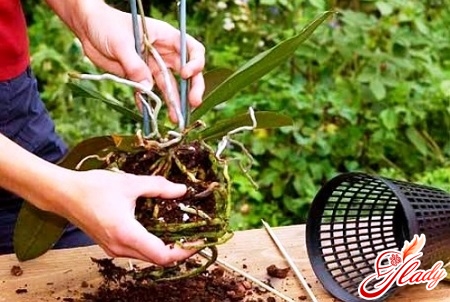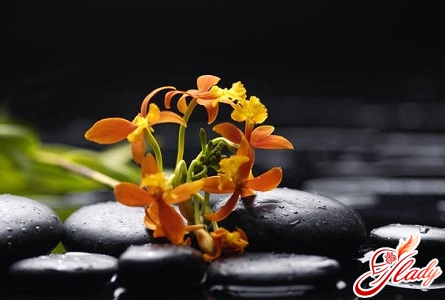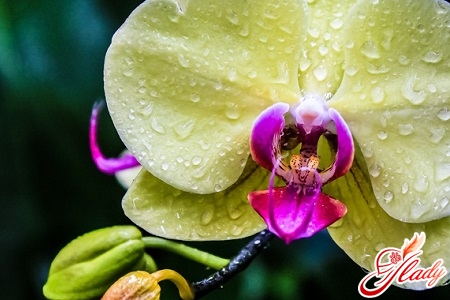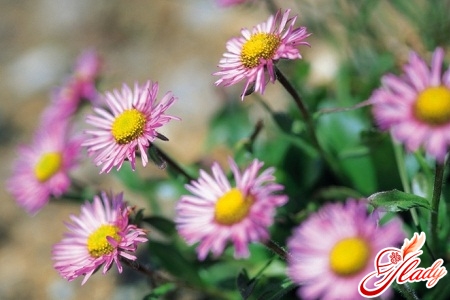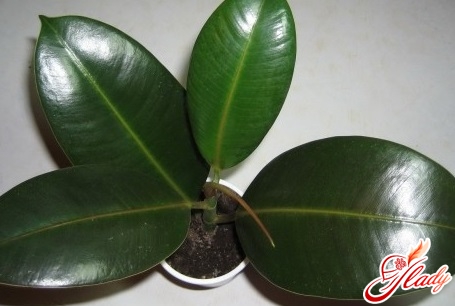 Ficus Melanie is one of the varietiesrubber (elastic) ficus, which, in turn, is considered the most popular and undemanding pottery crop - the care for such a fig is the most elementary. Long since, the rubber plants have been known as trees that provide family well-being, happiness and love. Today, the rubber fruit ficus is represented by a variety of varieties that are compact and miniaturized. Perhaps, for this reason, they are so often purchased for urban apartments or offices. Let's look at some of the features of the rubber fig trees before we go on to discuss Melanie's fig. For example, the Robust Ficus has bright wide leaves, and the foliage of the Belize Ficus is colored in three different colors: in the center - green, on the edges - white and pink. The leaves of the Teaneck ficus have a green core, and on the edges are specks of white / beige and pistachio. It is somewhat similar to Belize, but it is a more capricious plant. Ficus of Abidjan is distinguished by a bright burgundy, dark color of leaves; unpretentious. No less popular is the Black Prince variety with leaves, painted in a rich dark color. And, of course, Melanie is a ficus, distinguished by small foliage (no more than twenty centimeters) of dark green color.
Ficus Melanie is one of the varietiesrubber (elastic) ficus, which, in turn, is considered the most popular and undemanding pottery crop - the care for such a fig is the most elementary. Long since, the rubber plants have been known as trees that provide family well-being, happiness and love. Today, the rubber fruit ficus is represented by a variety of varieties that are compact and miniaturized. Perhaps, for this reason, they are so often purchased for urban apartments or offices. Let's look at some of the features of the rubber fig trees before we go on to discuss Melanie's fig. For example, the Robust Ficus has bright wide leaves, and the foliage of the Belize Ficus is colored in three different colors: in the center - green, on the edges - white and pink. The leaves of the Teaneck ficus have a green core, and on the edges are specks of white / beige and pistachio. It is somewhat similar to Belize, but it is a more capricious plant. Ficus of Abidjan is distinguished by a bright burgundy, dark color of leaves; unpretentious. No less popular is the Black Prince variety with leaves, painted in a rich dark color. And, of course, Melanie is a ficus, distinguished by small foliage (no more than twenty centimeters) of dark green color. 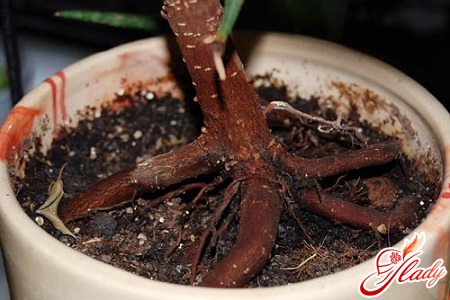
Features ficus Melanie
Today, rubber fig trees, includingMelanie, our market is supplied by Holland, which specializes in the derivation of more and more new varieties. On sale there are plants of various colors, sizes (from a couple of centimeters to two meters). Please note that these ficuses contain milky juice, which is poisonous in its composition, so it is not worth buying such a plant, for example, in children's institutions. Homeland of the ficus of Melanie is northeastern India and southern Indonesia. By the way, it is here that ficus is revered by Buddhists as a sacred tree. At the beginning of the growth period, Melanie is an unbranched plant with a lignified stalk. Over time, branching processes begin to occur - on the branches and on the stems, air roots actively develop, which, growing in a warm climate with good humidity and reaching the soil layer, form new trunks, from which the so-called banyan forms. By the way, due to air roots, this ficus is called a "snake tree". Its leaves have a large elliptical shape and a leathery texture, slightly tapering at the end. Foliage of a dark green color is alternate. The young leaf is reddish-brown in color. The same color and the stipule itself, which eventually falls off, leaving a scar behind it. At home Melanie does not bloom, but eventually forms one-centimetric fruit, called sikonium. They look like small figs, but they are not edible. On leaves sometimes you can observe small pores with milky juice. Once varieties of rubber plants were grown with an industrial purpose (to produce rubber), but today it is almost never practiced. Milky juice of figs, as it was spoken earlier, possesses strong irritating property and even at a single contact can cause sharp dermatitis or a strong allergy. The composition of the juice includes latex, enzymes and alkaloids - serious chemical components. Such a composition was "invented" by nature for the benefit of the plant itself - the milky juice heals wounds on the leaves and protects the ficus from pests. Even if you are an unprofessional florist, Melanie will not cause much trouble: caring for such a ficus is quite simple. The only thing Melanie reacts negatively to excessive lighting and dry air - the most comfortable ficus of this variety feels in conditions of good humidity. Therefore, growing Melanie at home, you need to constantly spray it. It is equally important to choose the right pot. Having bought initially a plastic container for a fig tree, in a couple of weeks it will be necessary to transplant into a more qualitative and size-appropriate pot. Soil does not need to be excessively filled with liquid - watering should be done only as needed. Please note that this aspect is one of the most important. Otherwise, you can corrupt the root system, and the leaves from the excess of moisture will twist and fall off.
Care for the Melanie Ficus
Melanie is a ficus that needs periodicfeeding in spring and autumn should be held approximately every two weeks. In winter, the top dressing should be added to the soil once a month. For this purpose, universal fertilizers are used. In the spring period, in order for lateral shoots to develop more rapidly, the ficus should be cut off the tip. Melanie prefers a good fertile soil of a porous structure. You can add a little turf soil to peat soil in combination with sheet humus and sand. This will allow the plant to grow faster, and the leaves of the ficus will have a good saturated color. It is equally important to know how and when to transplant the Melanie ficus - without a transplant, it is impossible to properly care for any plant. It is best to do this in the spring or in June. The transplant is performed as the root system completes the land coma. The ficuses respond well to transshipment from a smaller pot to a larger one - their growth becomes faster and more active. Growing Melanie at home, provide the plant with sufficient light - the light should be scattered, but bright. Direct rays are undesirable, because the leaves turn yellow and fall off. You can poke a little ficus, but in such conditions its growth will slow down. If the tree is in a dark, poorly lit place for a long time, the lower foliage will dry up. It is a heat-loving, well-tolerated plant that periodically requires spraying. Take care that in summer the temperature in the room is in the range of twenty-four to twenty-eight degrees. In winter, the temperature should be at least sixteen degrees, but not more than eighteen. The minimum threshold that Melanie can endure is thirteen degrees. If the temperature drop is short-term, then let's say the index is five degrees. At this time, you need to reduce watering. In rooms with central heating you need to provide the plant with frequent spraying. Ficuses of this kind do not tolerate drafts, and especially in those moments when an earth clod in a ficusa plant is moistened. Because of this, its leaves are covered with brown spots, and sometimes completely crumble. Caring for Melanie's figurines implies accurate watering. Immediately after drying the substrate layer, pour the ficus so that the earth becomes moist at about the depth of the finger. If the soil is waterlogged, the ficus will let you know about this abundant sudden leaffall, before which, as a rule, the leaves are covered with bright spots - watch out for the plant and do not allow this. Pay attention to the purity of the leaves, wiping them with napkins or damp sponges. This will allow them to be glossy and not lose their color. Do not forget to clean the stomata, allowing the ficus to breathe well and efficiently produce the process of photosynthesis. This is also an important step in the care of the plant. Over time, when the plant is aging, you may notice that the lower leaves die, and the trunk is bare. To keep the plant beauty and brightness, it must be cut. Usually it is done at the end of winter. If you spend a small pruning, having saved the ficus only from the top, then in the future the plant will not branch, as only one bud will wake up. In order to get a luxurious branchy bush, cut up to six internodes from above. There is another way, through which Melanie can give lateral shoots. Tilt the barrel as low as possible and lock the ficus in this position. At this moment, dominance is transmitted from the apical kidney lateral, which is higher than the others. The vertex will stop growth, after which the lateral bud will wake up and begin to actively grow. By providing the ficus with proper care, you will grow a strong, durable plant that can live for fifty years! In case you notice a deterioration in the growth of the tree, which can manifest itself in the fall of the leaves, their dryness or yellowing, optimize the care. Closely monitor the plant so that during growth it is not affected by diseases and pests such as thrips, chervets or aphids, which can cause severe irreparable harm to the health of the tree. Ficus Melanie is an ideal houseplant, which, despite its simplicity and undemanding, and also miniature, perfectly decorate the interior with its delightful bright green leaves. In addition, the ficus will perfectly clean the air, making it more fresh, which is especially important for residents of large contaminated cities.




